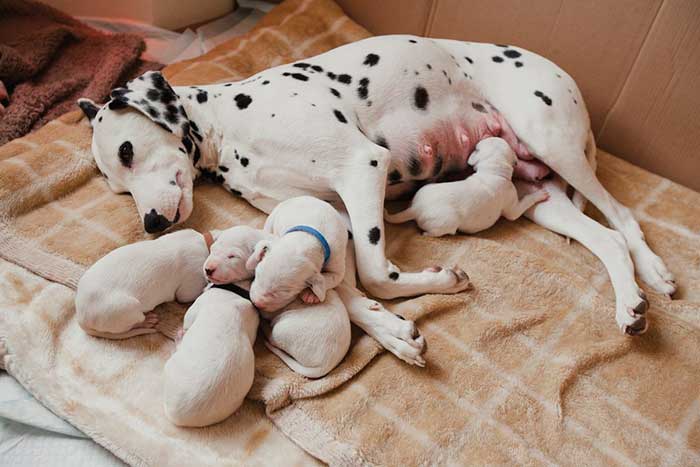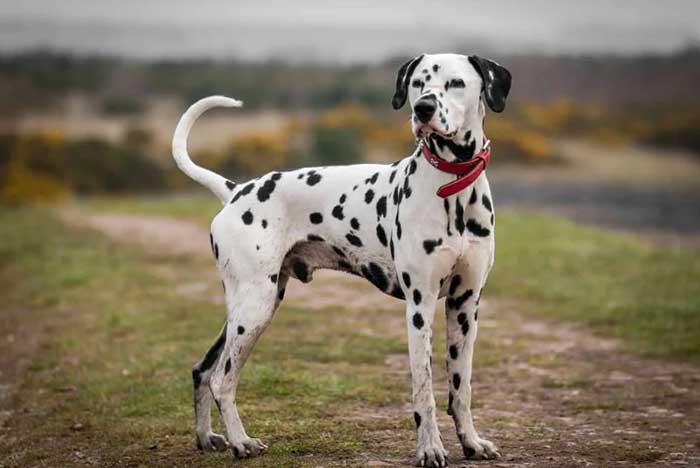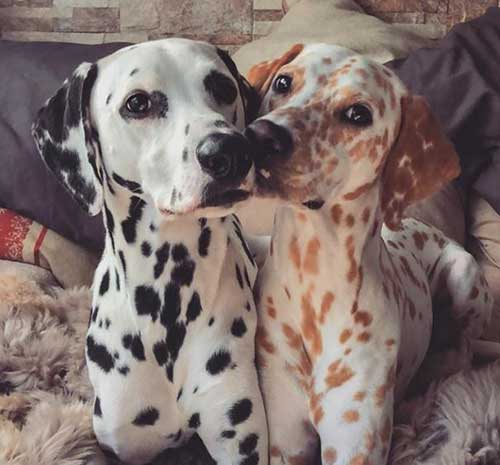Dalmatians have a very distinctive coat that makes them unique and stand out from others. However, a surprising fact about this breed is that Dalmatians are born with a pure white coat. So When do Dalmatian puppies get their spots? Keep reading and you will find the answer.
Do Dalmatian Puppies Have Spots When Born?
Baby Dalmatians with pure white coats will begin to have their first spots after 10 days. The spots will then continue to appear until they fully grow at 2 years old. The number and position of spots are set from birth, their skin has black pigment or liver visible to the eye. After 10 days, the hair that grows out of those pigment cells will have the color of that pigment and form spots on the dog’s body.

Dalmatian puppies have no spot when born
After a few days, you can determine the color of the spot with certainty. Also, you can rely on the puppy’s nose to guess the color of late spots. For example, if a dog’s nose is black, it will later have black spots. Or if the nose is brown, then the spot color will be liver.
Spots on dalmatians can vary in size and shape, and no two dogs are the same. The spots are evenly distributed all over the body, but denser on the head and tail.
How many spots are there on a Dalmatian?
Dalmatian owners are probably asked this question quite often. Have you ever tried counting the spots on a dog? I bet this will be a challenging task because these hyperactive dogs will not stand still for a count to occur. However, it is interesting to know that the average number of spots will be 150. Some have fewer, about 50 spots; some are denser with about 250.
Can Dalmatians get more spots when they age?

An Adult Dalmatian with full spots
Dalmatians have innate pigments on their skin from birth, which later grow into fur. As the dog grows older, these pigments will become bigger and have greater coverage. During their adult life after the age of two, they will not have any more spots other than the ones that have been set on their skin since birth.
Secondary spots
Secondary spots are smaller, freckle-like, and less common spots. They are also known as ticks or flecks. Dalmatians start to develop secondary spots on their ears and legs from the third month for the rest of their lives. As the dog ages, the smaller spots will turn white, especially the ones around the dog’s muzzle.
Odd colors variations on Dals
As per breed standards, Dalmatians’ spots appear in either black or liver (according to the AKC). There are some mutant dalmatians that will have other colored spots.
Orange lemon

Lemon Dalmatian on the right
These dals will have orange-yellow spots all over their body. This color is the result of the dog having 2 copies of the recessive pigment gene. This is a breeding fault, but indeed these dogs look very unique and gorgeous. The spot color is not too contrasting with the white so it’s quite pleasant to look at.
Grey blue
This is again a flaw in breed coloring. When the dog has another recessive copy of a gene related to the color pigment dilution factor. The number of blue-spotted dogs is less than that of lemon spotted. Despite its limited numbers, the Blue Dalmatian is not sought after as a rare color.
Tri-color
There are 2 types of tri-color Dalmatians: black, lighter brown, and white (type 1), and lemon-orange, and white (type 2). Lighter spots will be distributed around the muzzle and inner side of the legs. For example, a liver tricolor will have lemon-orange spots on the chest running down the front legs, while chocolate brown spots are evenly distributed on the back and head. These types of tri-color dogs are extremely rare, but type 1 is more noticeable than type 2.
Pure white
The pure white Dalmatian is a true genetic fault. These dogs are like having albinism. They have a beautiful snow-white coat color, but should not be selected to maintain the breed because disabilities such as complete deafness in both ears can be passed on to the next generation.
Other Characteristics
Dalmatians range from 19 to 25 inches in height and weigh up to 70 pounds. They have muscular and strong bodies that show dignity and elegance. They are very flexible and active, which is why firefighters often have dalmatians. This breed is also very suitable for those who like to play sports, bike, or run with their pets.
Dalmatians’ coats are short and shedding that need brushing every week. If you are allergic then dalmatians are not a recommendation for you no matter how much you like them. This breed does not require frequent bathing because they do not have ordor glands like other breeds. You just need to bathe them when they pick up dirt after playing outside.
Dalmatians are loyal, loving to their owners, and very intelligent. As active breed, they need daily exercise to release energy. On average, an adult dalmatian needs at least 2 hours a day of physical activity.
Conclusion
Spots on dalmatians are very interesting to know. They do not appear as soon as the dogs are born. “When do spots appear on dalmatians?” is the question that is asked by a lot of people who have newborn dals. It is for around ten days. In some cases, the spots will appear sooner or later than this time. The color of the spots can be liver, lemon, dilute blue, or even without spots.
Related posts:
